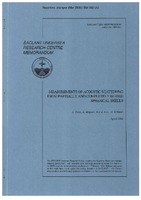| dc.contributor.author | Tesei, Alessandra | |
| dc.contributor.author | Maguer, Alain | |
| dc.contributor.author | Fox, Warren L. J. | |
| dc.contributor.author | Schmidt, Henrik | |
| dc.date.accessioned | 2018-10-11T14:08:54Z | |
| dc.date.available | 2018-10-11T14:08:54Z | |
| dc.date.issued | 1999/04 | |
| dc.identifier | 12212 | |
| dc.identifier.govdoc | SM-362 | |
| dc.identifier.uri | http://hdl.handle.net/20.500.12489/532 | |
| dc.description.abstract | Recent work at NATO SACLANT Undersea Research Centre has concentrated on investigating the use of low frequency sonars (2-20 kHz) in order to better exploit scattering features of buried targets that can contribute to their detection and classification. Part of the recent GOATS'98 experiment performed off the island of Elba, involved controlled monostatic measurements of scattering by spherical shells which were partially and completely buried in sand, as well as suspended in the water column. Analysis is mainly addressed to a study of the effect of burial on the dynamics of backscattered wave families, which can be clearly identified in the target responses. Data interpretation results are in good agreement with theory. | |
| dc.format | vi, 20 p. : ill. ; 12 fig. | |
| dc.language | English | |
| dc.publisher | NATO. SACLANTCEN | |
| dc.subject | Buried objects detection | |
| dc.subject | Target scattering | |
| dc.subject | GOATS'98 trial | |
| dc.subject | Mine burial and bottom conditions | |
| dc.subject | Acoustic scattering - Seafloor and sea surface | |
| dc.subject | Acoustic scattering by elastic structures | |
| dc.title | Measurements of acoustic scattering from partially and completely buried spherical shells | |
| dc.type | Scientific Memorandum (SM) | |
